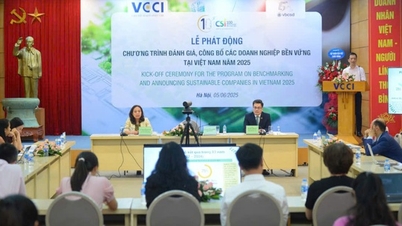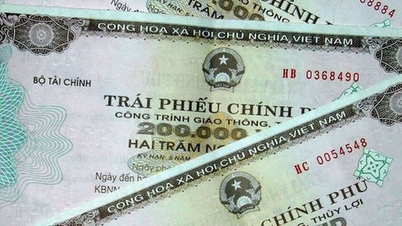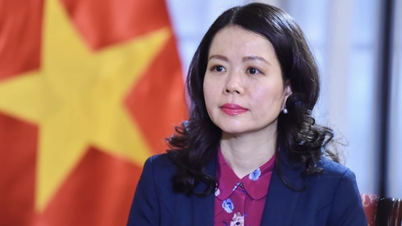In the last week of August 2023, commercial banks simultaneously reduced their deposit interest rates. Of which, four state-owned commercial banks including BIDV, VietinBank, Vietcombank and Agribank all reduced their deposit interest rates on August 23, with a reduction of 30 - 50 basis points for terms of 6 months or more. Other commercial banks have common reductions of about 10 - 30 basis points. Currently, the listed interest rates for institutional customers with a 12-month term at the four major banks are 5.2% and 5.9% for major joint stock banks.
Currently, savings interest rates have returned to pre-COVID-19 levels, so according to many financial experts, there is not much room for further reduction in the coming time. From March to June 2023, the State Bank of Vietnam (SBV) has continuously cut operating interest rates 4 times. The total discount rate and refinancing interest rate have decreased by 150-200 basis points, down to 3% and 4.5%, respectively.
As a result, instead of remaining at 9 - 10%/year as at the end of 2022, the highest deposit interest rate at banks is only 6 - 7%/year. Notably, since the beginning of September 2023, many banks have continued to reduce deposit interest rates. Specifically, interest rates at VPBank have decreased by up to 1%/year for many terms, falling below the 6%/year mark. Eximbank also reduced deposit interest rates by 0.1 - 0.25% percentage points for some terms. Meanwhile, with an interest rate of 4.75%/year, the group of banks with the highest interest rates in the market for short terms includes GPBank, OceanBank, PGBank, NCB, SCB, BacABank. For a 6-month term, GPBank has an interest rate of 5.7%/year, OceanBank is slightly higher at 6%/year; NCB, SCB and PG Bank all offer an interest rate of 6.3%...
According to forecasts from financial and banking analysts, the trend of decreasing deposit interest rates will continue, but there is not much room for reduction. Meanwhile, lending interest rates have a lag, so they will continue to decrease from now until the end of the year, when banks consume all the high-interest capital mobilized. However, lending interest rates are unlikely to decrease deeply in line with deposit interest rates, because the safety of the system must still be ensured. It is forecasted that the interest rate level from now until the end of the year will decrease by about 0.5 percentage points, but cannot decrease further. At the same time, the reduction of interest rates in the domestic market also depends on the world financial situation. If the US Federal Reserve (Fed) raises interest rates this month, it will be difficult for Vietnam to reduce interest rates deeply, because then, if interest rates are reduced, the dong will decrease, pushing the exchange rate with the USD up, creating instability in the foreign exchange market.
In their analysis, a group of experts from VNDirect Securities Corporation stated that lending interest rates will decrease sharply due to the decrease in capital costs of commercial banks thanks to the impact of the SBV's operating interest rate cuts since the beginning of the year and the issuance of Circular 02/2023/TT-NHNN allowing the extension of bad debt provisioning. The average 12-month deposit interest rate will decrease to 6.0 - 6.2%/year in the second half of 2023. The reason is the impact of the SBV's 4 operating interest rate cuts, slow credit growth in the first half of the year helping to reduce capital mobilization pressure, the Government boosting public investment, thereby pumping more money into the economy and the SBV still has room to loosen monetary policy.
A representative of the State Bank of Vietnam said that many monetary and credit policies have been issued and implemented by this agency in line with programs and solutions to remove difficulties, creating favorable conditions for businesses, especially small and medium-sized enterprises, to access capital. The ceiling interest rate for short-term loans for a number of priority sectors, including small and medium-sized enterprises, is currently only at 4%/year. By the end of June 2023, the average deposit and lending interest rates for new transactions in VND had decreased by about 1% compared to the end of 2022. Banks have proactively adjusted and implemented preferential credit programs and packages to reduce lending interest rates, with a reduction of about 0.5 - 3% depending on the customer for new loans.
Following the recent written directive from the State Bank of Vietnam, banks have committed to reducing lending rates by about 0.2 - 2.5 percentage points in the last six months of 2023, depending on the customer and sector. However, the effects of policies often have a certain delay and the actual beneficiaries of the policy will need a certain amount of time, and the commitment to reduce interest rates is no exception. It is expected that lending rates for the economy will continue to decrease in the coming time.
However, in reality, the rate of penetration of monetary policy into the economy is still quite slow. Although interest rates have decreased, credit growth remains at a record low. If businesses cannot access cheap capital, then reducing interest rates is not very meaningful.
According to Deputy Governor of the State Bank of Vietnam Dao Minh Tu, as of the end of July 2023, credit capital for the new economy reached about 12.4 million billion VND, up 4.56% compared to the beginning of the year. Thus, after recovering in June, credit recorded negative growth (-) compared to the previous month and was significantly lower than the same period in 2022 (9.54%). As of August 29, 2023, credit for the economy reached about 12.56 million billion VND, up 5.33% compared to the end of 2022 (increased by 9.87% in the same period in 2022). From the end of 2023 to the beginning of 2024, the operator will focus on solutions to "unblock" money supply and credit. Never before has monetary policy management been as difficult as it is now, when banks are holding money in stock, while businesses are holding goods in stock, with no outlet for their products.
Therefore, although the banking sector has continuously reviewed and resolved difficulties, the economy's total demand has decreased, orders have decreased, so businesses do not need to borrow capital to expand production and business. In addition, major central banks in the world tend to increase interest rates, indirectly affecting the capital absorption of the Vietnamese economy. In addition, an important factor considered a "barrier" to credit is the pressure on lending interest rates. At the end of last year, many banks pushed up deposit interest rates. In particular, the 12-month term reached more than 11%/year, causing short-term lending interest rates in the Vietnamese economy to reach 13-15%/year, and medium and long-term 17-18%/year.
Meanwhile, with Vietnam's inflation rate currently controlled at around 3-4%, according to financial experts, short-term VND lending interest rates should only be around 7-8%/year, and medium- and long-term lending at around 10-12%/year, which is reasonable. However, the problem that banks are facing is that the cost of capital until the first 6 months of 2023 is still high, so it is difficult to reduce lending interest rates. Therefore, it is necessary to reduce the average cost of capital mobilization of banks, and inventory prices must be reduced.
Currently, the mobilization interest rates of the state-owned banking group have decreased by 0.3-0.5%, while the private banking group has decreased by more than 0.5-1% in August and is on the way to further decrease. Since the beginning of the year, the mobilization interest rates have decreased by 1-2.5% depending on the term - a deeper decrease than the reduction in the operating interest rate of the State Bank. Currently, the mobilization interest rates of the system in most terms have decreased to the same level as in September 2022, with only the mobilization interest rates for 3-month and 6-month terms being 0.3% higher than in September 2022. However, compared to the record low interest rates during the COVID-19 period, the current interest rate level is still about 0.3-1% higher. Meanwhile, the interest rates in the interbank market have remained at a record low throughout August.
In addition, credit is still expected to improve in the last months of the year when interest rates gradually decrease. After decreasing in July, credit recovered in August 2023 and by the end of August reached an increase of 5.33%. This shows that credit has regained growth momentum, in line with the general trend of previous years when the credit growth rate in the last months of the year was always twice as high as in the first half of the year.
A banking expert said that with factors such as the economy showing more positive signs, the manufacturing and export sectors gradually recovering, and interest rates continuing to decrease sharply, credit growth in the last months of the year is forecast to increase rapidly, even doubling that of the first half of the year. In recent years, Vietnam's economy has tended to recover strongly in the third quarter of 2023 and credit growth in the last 6 months of the year is always double that of the first 6 months. Although credit growth only decreased in July, in August, the credit growth rate recovered quite well and is forecast to maintain this momentum until the last months of the year when lending interest rates continue to decrease and the number of orders improves somewhat.
However, analysts also recommend that we should continue to lower lending interest rates, not deposit interest rates, because monetary policy has reached its limit. If we continue to lower deposit interest rates, it will cause many consequences. We should avoid hastily lowering policy interest rates, and control money supply growth around the safe level (around 10%).
Therefore, in the context of good recovery signals coming from the market and policies to encourage investment, consumption and the Government's real estate rescue work... the driving force to increase and improve credit demand will appear at the end of the year and early next year, in addition to the orientation of lowering interest rates, credit room allocated to banks, the State Bank needs to apply monetary policy tools to support the reduction of "capital mobilization inventory" by some tools such as adjusting required reserves, implementing flexible open market operations. Only then can we both ensure the safety of the system and achieve optimal efficiency from solutions to "unblock" money supply and credit.
Source link


































































































Comment (0)